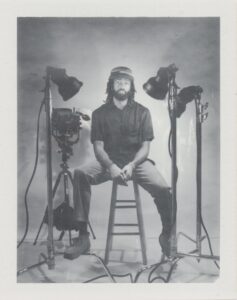Los Angeles-based multidisciplinary artist Adam Davis brings his 1850’s tintype photo practice to the South Side Community Art Center!
On June 3rd and June 4th, South Side Community Art Center will host artist Adam Davis and his ‘Black Magic’ tintype photography project. Through this participatory photo activation, Adam will offer free portrait sessions to members of the Chicago community.
Davis will create 2 portraits per session – one for participants to take home and one for his own archive. Traveling to historically Black cities and communities nationwide, Davis is in pursuit of creating 20,000 tintype portraits of Black Americans with the goal of creating the largest contemporary archive of Black American portraits.
Themes of Afrofuturism, celebrating the Art of Magic, and Queerness have become foundational to Davis’ process throughout the project.
Black historical art spaces, such as SSCAC are critical to Davis’ intent to be in conversation with the legacy of Black artistic innovation, community engagement, and Black archival contributions to the culture.
Please read below on how to participate:
Portrait sessions will take place at SSCAC from 1pm – 4pm.
Each portrait session will take 20 – 30 minutes, which includes a chemical development process. Due to the nature of this process, RSVP time selections are required to participate.
We kindly ask that you select 1 time slot for yourself only, so that we’re able honor each participant per session.
RSVP HERE

Adam Davis (b. 1994) is an American Visual Artist, Educator, and Arts Education Advocate born and raised in Brooklyn, New York. Davis obsessively seeks to apply his passion for creativity, communication, and storytelling to assist in finding solutions to problems that hinder diverse and equitable cultural progression at the intersection of the Arts and Education within the Black community. With a degree in Education and 6 years in the classroom, Davis’ work intends to document the lives of Black bodies in a way that educates, empowers, and returns the permission to dictate how they are photographed to the subject. Delving into personal narratives on religion, queerness, mental health, and the greater understanding of the global African diaspora, Davis creates images, both moving and still, from a place of curiosity.
Davis is a resident at the 54 year old Black Owned and operated community arts organization St. Elmo Village in Los Angeles, California. Here Davis developed his darkroom practice on campus in the facilities opened by founder Roderick Sykes. Davis’ second solo exhibition, titled Black Magic, was created at the Village and opened at the Byrd Museum in Los Angeles, where his darkroom practice lies at the center of his practice of making tintype portraits. The exhibition monograph was successfully published soon after by Paper Chase Press and debuted at the New Art Dealers Alliance fair in Miami during Art Basel Week 2021. Davis’ work has been featured in the LA Times, SKEW Magazine, Umber Publications, and AFAR among others.



